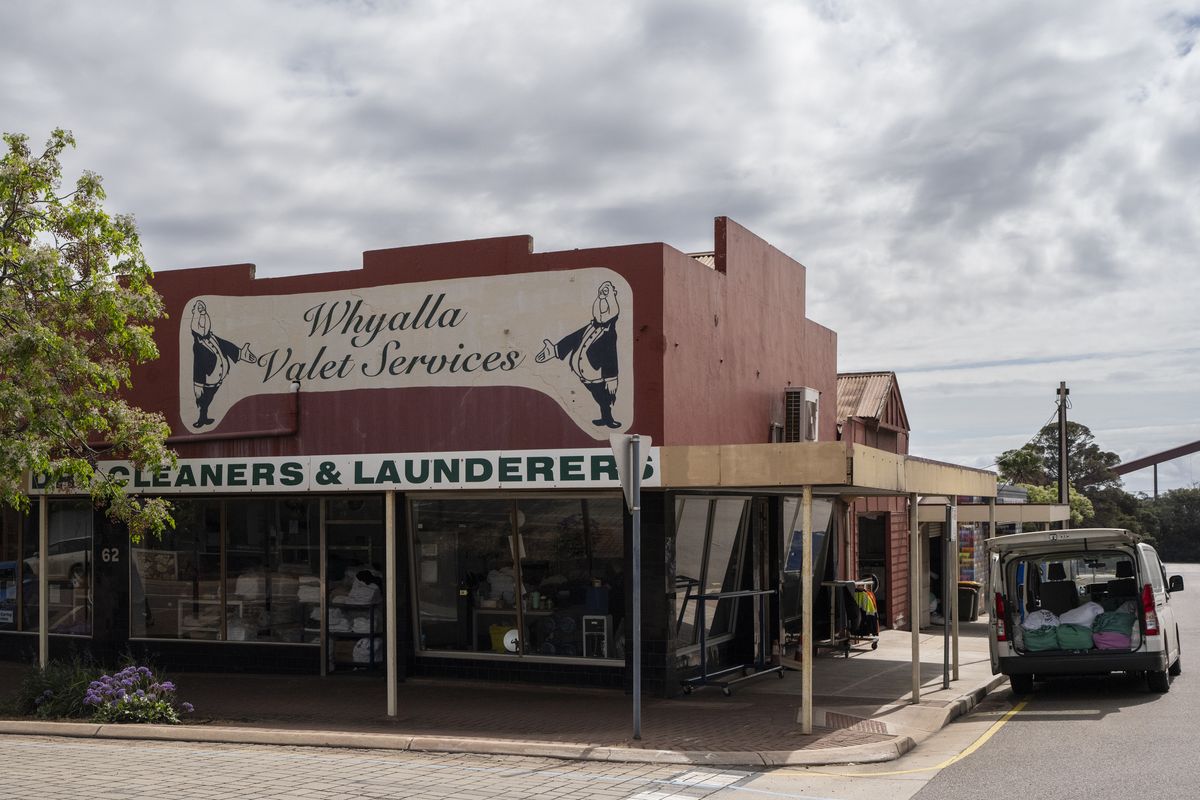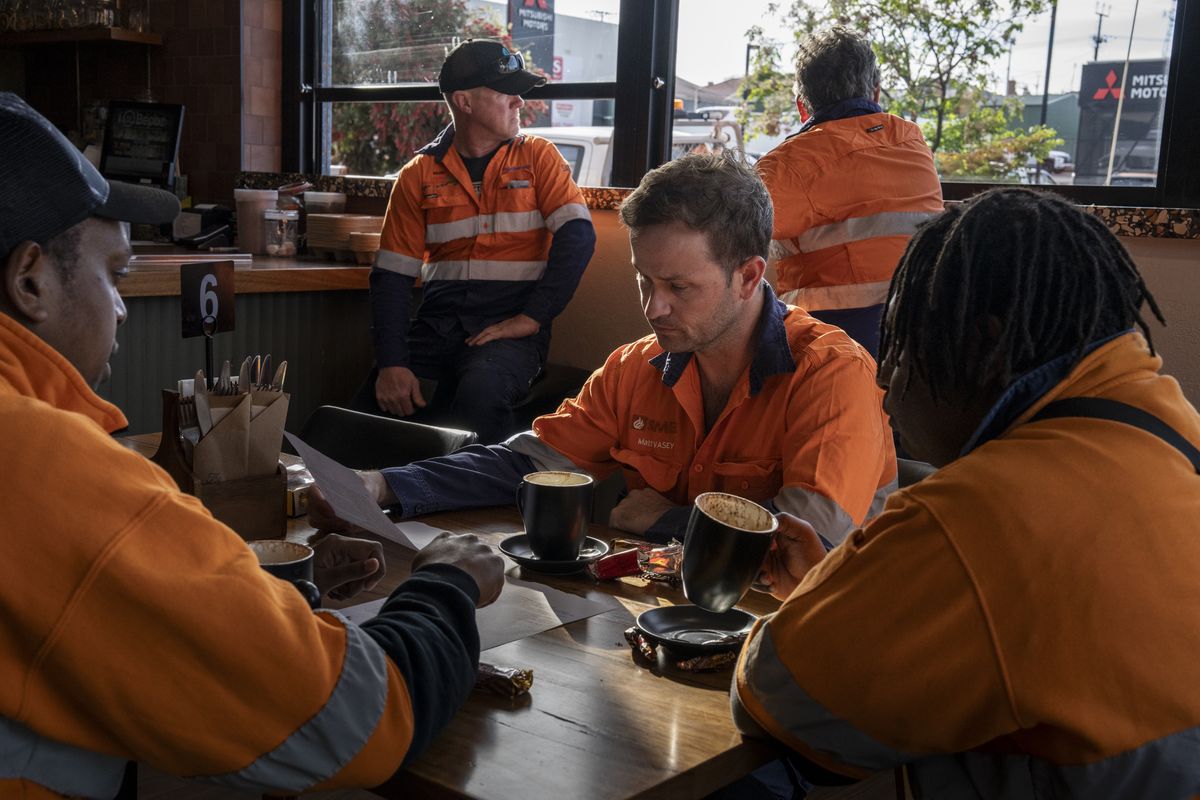Australia, the land of iron ore exports, faces a green reckoning
Whyalla's steelworks glows at night. The struggling steel town in South Australia is hoping to become a green iron hub by combining iron ore deposits, abundant renewable energy, and green hydrogen from a state-owned plant. MUST CREDIT: Mridula Amin for The Washington Post (Mridula Amin/for The Washington Post)
WHYALLA, Australia - For more than a century, Australia has fed the world’s hunger for iron ore. Vast swaths of the rusty red Outback have been dug up and delivered overseas to make the steel that helped transform other nations: first the United States, then Japan and most recently China, which buys more than 80% of Australia’s iron ore.
Now that trade is at risk as China’s slumping economy dries up its demand for construction materials.
But there is a bigger threat. Governments around the globe are beginning to crack down on the steel industry, which is responsible for roughly 10% of global CO2 emissions.
Australia - the world’s biggest iron ore exporter, accounting for almost 60% of the global market - has the most to lose. That’s because its ore happens to be poorly suited for making the “green” steel the globe increasingly demands.
Australian iron miners are trying to adapt and maintain their place in the global market. For decades, they have been pulling raw iron ore out of the ground and exporting it to be made into steel. That was the dirty, basic commodity way.
But as Beijing begins to look elsewhere for better ore, Australian miners are looking to move up the value - and the environmental - chain by using renewable energy to turn their ore into “green” iron for export.
Companies and state governments are pressing ahead with efforts to use green hydrogen - which is made using solar or wind power and produces almost no carbon emissions, unlike coal - to enable them to churn out more valuable and environmentally friendly “green iron” for export. Steelmaking nations such as Japan, South Korea, Germany and China will turn that iron into green steel for electric vehicles, appliances, bridges and skyscrapers.
“Things are moving in Australia; it’s just a question of whether they are moving fast enough,” said Simon Nicholas, a Sydney-based steel analyst at the Institute for Energy Economics and Financial Analysis, a global think tank.
Companies in other parts of the world - from Sweden and Canada to Brazil and parts of Africa - are attempting to make the same shift.
In Western Australia, Fortescue, one of the world’s biggest iron miners, is trialing technology that could transform its vast amounts of low-grade ore into green iron. And in Queensland, a new $2 billion project aims to turn high-grade ore into green iron for export.
But it is South Australia that is best positioned to pivot, Nicholas said.
The state has all the ingredients for green iron, according to analysts and officials. Though it mines far less than Western Australia, South Australia is rich in magnetite, a type of iron ore that, when processed, is pure enough for making green iron and steel. It also has abundant wind and sun, one of the country’s two remaining steelworks and, importantly, political resolve.
“We have the chance to do something special,” South Australia Premier Peter Malinauskas said in an interview. “We can build the state’s prosperity not on the back of polluting the planet, but rather saving it.”
- - -
A global race
Steelmaking is normally a dirty business. Iron oxide ore is fed into coal-fired blast furnaces, which remove the oxygen and produce iron that can be strengthened into steel. For each ton of steel, the process creates about two tons of CO2.
More than 70% of the world’s steel is still made using the centuries-old technique. But efforts are underway to clean up the industry, driven in part by tougher regulation. The European Union will impose levies on steel and other carbon-intense imports starting in 2026, and the United States is considering similar steps.
“We don’t get to net zero by 2050 globally without decarbonizing steel,” Malinauskas said. “Markets are realizing this. Regulators are realizing this.”
One way to clean up the industry is by replacing blast furnaces with a process called direct reduction, which uses natural gas or hydrogen to lower emissions.
Only a handful of countries have both the iron ore and green hydrogen ability required, Nicholas said.
Green hydrogen is made by using renewable electricity to split water into hydrogen and oxygen. Unlike coal or natural gas, the only byproduct of burning hydrogen is water. But transporting it is tricky, which means it’s best used where it’s made.
That gives Australia - the sunniest continent in the world - an advantage, especially South Australia.
South Australia has become a renewable energy leader over the past decade: A full three-quarters of its power comes from renewable sources, and it’s on pace to hit 100% by 2027.
The state doesn’t just have lots of wind and sun. It has both in the same place, which means it can usually rely on at least one for power. Forty percent of its homes have solar panels and more than two dozen wind or solar farms have sprouted along its sunny, windswept gulfs.
Now the state is preparing to turn its renewable power into green hydrogen with a state-owned plant. Construction will begin later this year in the struggling steel town of Whyalla, and is due for completion in 2026.
Whyalla’s steelworks plans to use the hydrogen to make iron for export by 2027. With the aging plant and its multinational owner facing financial problems, however, the state is also courting some of the world’s biggest steelmakers to take advantage of its natural resources and make green iron here.
South Australia also has the other main ingredient for green iron: high-quality iron ore. The state has an estimated 19 billion tons of magnetite, whose magnetism enables it to be purified to the level required for direct reduction.
Sweden and Canada also have rich seams of magnetite. And several countries have other types of ore suitable for direct reduction. In Guinea, one of the world’s biggest mines will soon start sending high-grade ore to China. And in Brazil, multinational Vale is exploring making green hydrogen and green iron.
There is also competition within Australia. Its biggest iron miners, Rio Tinto and BHP, have teamed up to study how to use direct reduction on their vast reserves of lower-grade hematite.
Fortescue believes it has already solved that puzzle. The company has built its own green hydrogen plant and is trialing a unique direct reduction process to produce green iron next year.
The technology works in a lab but the pilot plant will show whether it’s viable at scale, Fortescue Metals CEO Dino Otranto said. If so, it could upend the iron ore trade, roughly 97% of which isn’t pure enough for traditional direct reduction. Fortescue says it is in talks to sell up to 100 million tons of green iron to China in the coming decades.
Otranto admits it will be years before Fortescue’s green iron production eclipses its ore exports. That gives Whyalla and its aging steelworks a window of opportunity.
- - -
A steel town’s second chance
Whyalla’s fortunes have risen and fallen with the smoke billowing from its blast furnace since 1941. For three decades, the town flourished. But when steel prices collapsed in the mid-1970s, its shipyard closed, the steel mill shed jobs, and the population shrank.
In 2016, the steelworks nearly shut for good when its owner collapsed. British billionaire Sanjeev Gupta and his company, GFG Alliance, bought the steelworks and its iron mines and promised to spend up to $1 billion to modernize them.
But both Gupta and his steelworks have suffered setbacks. GFG is under investigation for fraud in the United Kingdom, and the blast furnace has been offline for several months this year due to supply and repair issues.
“There is a combination of anxiety, anticipation and uncertainty,” said Eddie Hughes, a former steelworker who represents the region in state parliament. “There have been a lot of promises. What we want to see is delivery.”
When Malinauskas announced that the green hydrogen plant would be built in Whyalla, many here saw it as the town’s second - and likely last - chance.
Half an hour outside Whyalla, the transition to a greener future is already visible. At GFG’s South Middleback Ranges Mine, huge ochre-colored pits that once held hematite now sit empty while a massive gray magnetite pit is bustling and planned for expansion.
“The hematite for us is coming to an end,” said Gavin Hobart, who leads GFG’s growth and transformation plan for Whyalla. “But what South Australia is rich in is magnetite.”
Magnetite now makes up a quarter of GFG’s production, and the company plans to grow that.
GFG is spending $1 billion to replace the coal-fired blast furnace with a direct reduction shaft and make other upgrades, Hobart said. The shaft will use natural gas initially and then GFG hopes to use green hydrogen from the state plant to make green iron - although there are significant challenges ahead.
Some of them are technological. The company says its ambitions could be limited by how much hydrogen the state plant will be able to produce and at what price.
Others are more existential. The state is worried that GFG will fail to modernize, or worse. Slumping steel and iron ore prices mean the Whyalla business is now losing money, and local media have reported that officials have sought advice should it go into voluntary administration. (Gupta has vowed to weather the downturn and revitalize the steelworks.)
For many in Whyalla, salvation seems close but uncertain.
“Green steel is our future,” Mayor Phill Stone said. “We have to change, or Whyalla will die.”
- - -
Graphic:
https://washingtonpost.com/documents/be5ed637-0250-44ab-83f4-6903d58d4a2f.pdf








